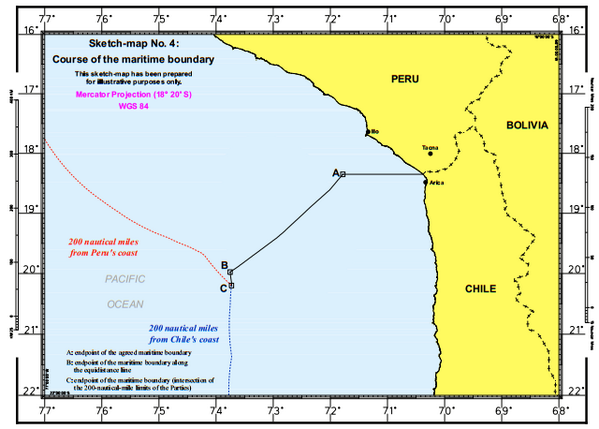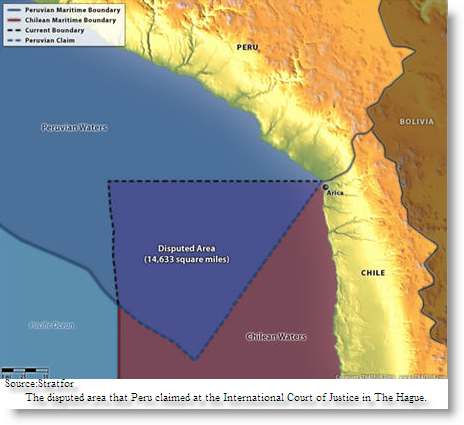The International Court of Justice on Monday issued a long-awaited ruling on a maritime border dispute between Peru and Chile, handing over to Peru control over a large swath of Pacific Ocean off its coastline.
 The ruling resulted in celebrations in Peru, while Chilean officials said they strongly disagreed with the court’s decision but would respect it.
The ruling resulted in celebrations in Peru, while Chilean officials said they strongly disagreed with the court’s decision but would respect it.
The ruling essentially wraps up a dispute over maritime borders between Peru and Chile that dates back to two fishing treaties, signed in 1952 and 1954.
Chile argued that these treaties were a recognition of the maritime border, but Peru differed and after two decades of failed attempts to negotiate with Chile over a maritime border based on international law, Peru took its case to The Hague in 2008.
The issue of borders dates back to the 19th Century War of the Pacific, which resulted in Chile gaining large swaths of Peruvian and Bolivian territory.
The land border between both countries — Peru lost Arica and Iquique, and regained Tacna in a plebiscite — was finally established in 1929 with the Treaty of Lima.
At issue in the maritime border dispute was the ownership of some 38,000 square kilometers of fishing-rich waters that Chile has controlled. Another 28,000 square kilometers of ocean was also under dispute. Peru had claimed that area, while Chile had argued that it should stay under international jurisdiction.
 The court’s judgement, which was read by its president Judge Peter Tomka, gave Peru the right over almost 50,000 square kilometers, which is over 70 percent of the area that was at stake.
The court’s judgement, which was read by its president Judge Peter Tomka, gave Peru the right over almost 50,000 square kilometers, which is over 70 percent of the area that was at stake.
The previous border was a straight line that stretched 200 square kilometers out from the Peruvian and Chilean land border. The new ruling stretches out 80 square kilometers from the border and then slopes south, giving Peru more control over the ocean waters.
As a result of the new sloping border, Peru also took over all of the 28,000 square kilometers that were previously part of the high sea.
President Ollanta Humala gave a statement following the ruling saying that the court’s decision is “historic” and that it will help create stronger ties with Chile. The televised statement had Humala standing in front of a painting of war hero Mariscal Caceres, who during the War of the Pacific continued to fight against the Chilean troops from the Andean highlands when Lima had already surrendered.
“Peru is pleased with the result of this option for peace,” said Humala. “The most important court in the world has settled this controversy, established in a definitive and peaceful way with international law.”
 Humala later went outside the presidential palace to address flag-waving crowds that had gathered in Lima’s central plaza to hear the court’s opinion. “This is news that will change the history of Peru, as it changes the map of Peru,” Humala said.
Humala later went outside the presidential palace to address flag-waving crowds that had gathered in Lima’s central plaza to hear the court’s opinion. “This is news that will change the history of Peru, as it changes the map of Peru,” Humala said.
In Chile, the mood was much more somber. President Sebastian Piñera and incoming president Michele Bachelet, who takes office in March, both said that they disagreed with the court’s opinion. However, the authorities said they would comply with new border.
“This is a painful loss,” said Bachelet. “The court’s decision, which we don’t share and regret, impacts a part of an exclusive economic zone where Chile has economic rights.”
Chilean officials pointed out, however, that even though they lost a large swath of ocean territory, the country did hold on to the most fishing-rich area. Fishing companies say that the prized stock of anchovy is located in shallower waters closer to land.
Chile is the world’s second biggest exporter of fishmeal, made from anchovy and used as fertilizer and animal feed. Peru is the world’s biggest fishmeal exporter.
The area that Peru has gained control over also includes jack mackerel and sardines. The fishing industry estimates that the added territory won’t have a major impact on the fishing sector, but that it will benefit small-scale fishermen in southern Peru.
Although Peru’s southernmost region of Tacna does not gain additional ocean territory until after the first 80 miles, Aldo Fuster, president of the Tacna Chamber of Commerce and Industry, believes it is now fundamental that a port be built in Tacna. The port would not only serve artisanal fishermen but boost the export of mining and agroindustrial products, as well as provide Bolivia with another access to the Pacific, Fuster said. Currently, foreign trade and the Tacna Free Zone operate via the Chilean port of Arica.





